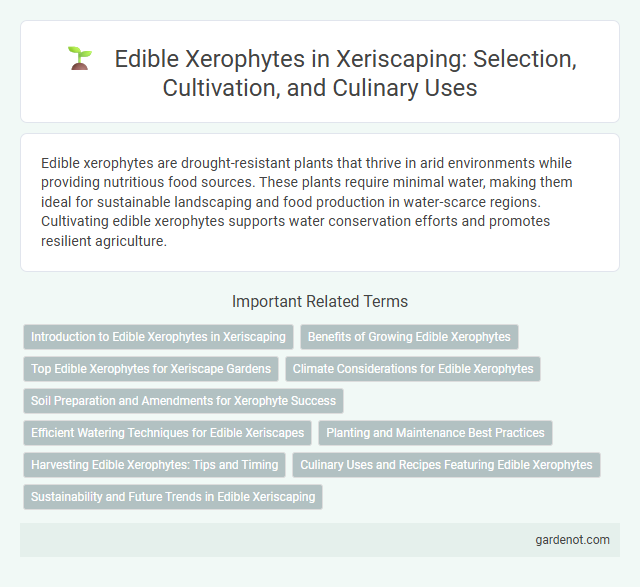Edible xerophytes are drought-resistant plants that thrive in arid environments while providing nutritious food sources. These plants require minimal water, making them ideal for sustainable landscaping and food production in water-scarce regions. Cultivating edible xerophytes supports water conservation efforts and promotes resilient agriculture.
Introduction to Edible Xerophytes in Xeriscaping
Edible xerophytes are drought-tolerant plants that produce nutritious fruits, leaves, or seeds, making them ideal for xeriscaping in arid and semi-arid regions. These plants, such as prickly pear cactus, agave, and purslane, thrive with minimal water while offering sustainable food sources and reducing irrigation needs. Incorporating edible xerophytes in xeriscaping not only conserves water but also enhances landscape biodiversity and food security.
Benefits of Growing Edible Xerophytes
Growing edible xerophytes conserves water by thriving in arid conditions with minimal irrigation, making them ideal for sustainable agriculture in drought-prone regions. These plants provide nutrient-rich, drought-resistant food sources such as prickly pear cactus and amaranth, enhancing food security while reducing reliance on water-intensive crops. Cultivating edible xerophytes also promotes soil health and biodiversity by adapting to harsh environments without chemical inputs.
Top Edible Xerophytes for Xeriscape Gardens
Top edible xerophytes for xeriscape gardens include prickly pear cactus, amaranth, and purslane, all renowned for their drought tolerance and nutritional benefits. Prickly pear offers both fruit and pads rich in vitamins and antioxidants, while amaranth provides protein-rich seeds and leaves. Purslane stands out with its omega-3 fatty acids and ability to thrive in dry, nutrient-poor soils, making these plants ideal for sustainable, low-water gardens.
Climate Considerations for Edible Xerophytes
Edible xerophytes thrive in arid and semi-arid climates where water conservation is critical, making them ideal for xeriscape landscaping in drought-prone regions. These plants are adapted to withstand extreme temperatures and minimal rainfall, reducing the need for supplemental irrigation. Selecting native edible xerophytes further enhances sustainability by aligning with local climate patterns and soil conditions, optimizing growth and yield.
Soil Preparation and Amendments for Xerophyte Success
Soil preparation for edible xerophytes requires well-draining, sandy or loamy soil enriched with organic matter to retain moisture without causing waterlogging. Incorporating amendments such as compost, aged manure, and biochar enhances soil fertility and structure while improving water retention and microbial activity. Proper soil pH adjustment to a neutral to slightly alkaline range (6.5-8.0) supports nutrient availability vital for xerophyte growth under arid conditions.
Efficient Watering Techniques for Edible Xeriscapes
Efficient watering techniques for edible xeriscapes include drip irrigation and soil moisture sensors to deliver precise amounts of water directly to deep-rooted edible xerophytes like prickly pear cactus and agave. Mulching with organic materials retains soil moisture, reduces evaporation, and maintains nutrient levels essential for fruiting plants such as pomegranate and olive trees. Implementing these strategies can reduce water use by up to 50% while promoting healthy growth and maximizing edible yield in arid climates.
Planting and Maintenance Best Practices
Planting edible xerophytes requires selecting drought-tolerant species like prickly pear cactus, agave, or rosemary, suited to arid climates with well-drained soil and full sun exposure. Maintenance involves minimal irrigation, focusing on deep, infrequent watering to promote root strength, alongside regular pruning to encourage healthy growth and prevent disease. Mulching with organic materials conserves soil moisture and suppresses weeds, optimizing water efficiency in sustainable xeriscape gardening.
Harvesting Edible Xerophytes: Tips and Timing
Harvesting edible xerophytes requires precise timing to maximize flavor and nutritional value, often aligning with the plant's natural growth cycles in arid environments. Techniques such as selective picking during peak maturity and minimal water use during harvest preserve the plant's resilience and sustainability. Understanding specific species like agave or prickly pear aids in identifying the optimal harvest window, improving yield and quality in xeriscaped gardens.
Culinary Uses and Recipes Featuring Edible Xerophytes
Edible xerophytes such as prickly pear cactus, agave, and mesquite are prized for their unique flavors and drought-resistant properties, making them ideal for sustainable cooking. Prickly pear pads are often grilled or sauteed, adding a tangy, slightly tart taste to salads and tacos, while agave syrup serves as a natural sweetener in desserts and beverages. Mesquite flour, rich in protein and fiber, is incorporated into baked goods and tortillas, infusing dishes with a subtle, nutty flavor.
Sustainability and Future Trends in Edible Xeriscaping
Edible xerophytes such as prickly pear cactus, agave, and amaranth exemplify sustainability through their minimal water requirements and ability to thrive in arid climates, reducing irrigation demand and preserving local water resources. Future trends in edible xeriscaping emphasize integrating drought-tolerant food plants into urban landscapes, promoting food security and resilience against climate change. Advances in plant breeding and permaculture design are driving more efficient, multifunctional xeriscapes that combine aesthetics with sustainable food production.
Edible xerophyte Infographic

 gardenot.com
gardenot.com